|
Letter from
America - Yucca nana
Don Campbell |
Ed: I have
been in weekly contact with Don Campbell for a good few years. Don is the
chairman of the Chinle Chapter of the Colorado Cactus Society
Trevor,
Finally getting around to
reading what you sent via regular mail. Specifically the bit on Yucca nana.
I'm definitely not an
authority on Yuccas. I love to see them in habitat and they definitely have a
place in xeric gardens, however, they tend to be a bit like prickly pears for
me.
I suspect I've seen a number
of what is being referred to a Y. nana in various places in Utah. These
tiny little plants are truly appealing and tend to stick in one’s memory.
Years ago, while living in the
Denver area, I became intrigued by some really cute tiny little
"spherical" Yuccas we saw in the San Rafael Swell area. I guess the
little beauty was attracted to me because it followed me home and took up
residence in a small outdoor C&S garden I had started. For the next year or
two I took really good care of the little waif. However, it's hard to imagine
the disappointment I experienced when the little guy rewarded me by growing up
to be the same size and looking just like all the other Y. harrimaniaes I've
seen. My suspicion is that there is some soil or other habitat factor that
causes these plants to assume and maintain their Lilliputian stature in some
particular habitats but revert to a normal size under other conditions.
The German translation you
sent refers several times to finding plants with the flower stalks being cut off
and the fruits missing. The author’s assumption was that naughty seed
collectors had done the dastardly deed. My assumption, however, is that the
culprit walks on four feet and wears a fur coat. The fresh stalks and flowers
are a real juicy, tasty treat for deer and other critters in the desert. I've
seen many yuccas and agaves that have been "topped" by hungry, thirsty
critters just before the plants are able to mature the flowers and produce
fruits. Last spring, in fact, I watched a doe in my back yard make a direct bee
line to one of my flowering yuccas and begin munching on the stalk and immature
flowers. I shooed her away but not before she took off a couple of stalks. I
also lost the young flower stalk tips on my Hesperaloe this past year. The
Hesperaloe, however, just branched out and continued blooming the rest of the
summer.
I'll try to keep better track
of any future Lilliputian sightings in the Utah deserts. Memory tells me that
I've seen lots of them over the years and in many different places. I do not
currently have any of these growing in my garden. However, several
years ago I
did rescue an underachieving yucca from a road cut in the Vernal, UT area and
planted it in my garden. It too promptly responded to my TLC by assuming
"normal" proportions, clumping and flowering profusely. In fact this
is the plant that the deer nipped off last spring.
Regards, Don
|
In Search
of Pediocactus simpsonii Vic
Abell |
|

The
Wilson Arch in Utah.
(You can click the images in this article for a better view.) |
Ed: My friend
Vic was keen to see more cacti of the southwest and I was happy to send him the
locations of some plants which were on his way and might particularly interest
him. While he was there would he look up a little Pediocactus species I had seen
in the Abajo mountains of Utah? Read on…
8th April: I left the
Econolodge in Cortez, Colorado driving north. Passing Monticello in Utah I came
to an amazing natural archway in the red sandstone which turned out to be Wilson’s
Arch. I parked up and climbed up to the base of the arch to admire the view back
to Monticello and the snow capped mountains.
Next stop was Hole In the Rock which
looked a bit too touristy for my taste but turned out to be quite
interesting with all sorts of curiosities and included a cactus garden
with some nice plants including some Sclerocacti. I took the opportunity
to have a look at a more detailed map in the gift shop as my map didn’t
show Harts Draw Road. This was where I could find the special site for Pediocactus
simpsonii that Trev had asked me to look our for. The least I could do
considering all the help he had given me and the excellent plant info, of
course I’d like to see this plant in habitat as well! Fortunately I soon
found the road on the map, just off U211 which I’d passed earlier. So
full of anticipation I drove back and took the turn into Harts Draw Road.
I noticed I was quite low on fuel, it couldn’t be that far? |
| My notes from Trev said
approximately 3.2 miles so I counted down on the mileometer and pulled up
at the side of the road. Hastily I jumped out of the car and grabbed my
camera from the boot and off I marched on a mission, GPS in hand. Firstly
I took the left hand side of the road and soon came across a cactus which
turned out to be Echinocereus triglochidiatus ‘inermis’ (below
left) which was growing in the partial shade of a pine tree. I took a
photo and carried on, searching the ground for cacti and checking the GPS
as I went. A little further on I found Sclerocactus parviflorus
growing in sandy soil where the ground started to slope off into what I’d
describe as a ravine with huge boulders. |
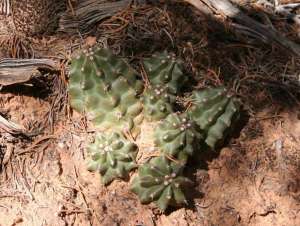
The
spineless form of Echinocereus triglochidiatus found by Vic in Utah |
|
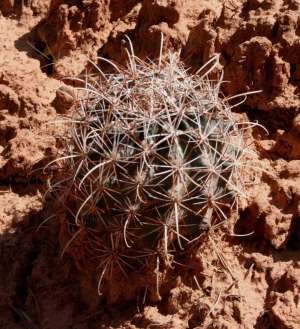
Sclerocactus
parviflorus |
The pines became more
abundant here and I spotted more Sclerocacti growing along with Opuntias
and Yuccas. I stopped to have a look at the GPS, the N co-ordinates
matched those given to me by Trev but the W co-ords were someway off, I
was still a GPS virgin and hadn’t quite mastered it yet but realised I
was looking in the wrong area, so I took the steep walk back up to the
road and of course looked for plants along the way. I soon came to the
road a little further up from where I’d parked and crossed over to the
other side where I had a little look around, I found a small Opuntia, low
growing with cylindrical stems maybe O. fragilis (right) but no
Pediocacti.
I then drove a bit further along the
road and parked up, checking the GPS showed that I was very close. I took
the right hand side of the road and came to a flat grassy area only a
short distance from the road with low bushes and the odd pine tree. I was
getting closer and closer and the anticipation was becoming more intense
– got it – cross-hairs on the GPS, checking the ground I couldn’t
see any cacti but they had to be around there somewhere! |
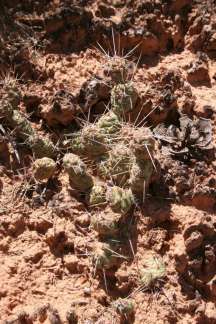
Opuntia
fragilis |
The GPS indicated an accuracy
of around 10ft so I scoured the ground almost on my hands and knees and there it
was - Pediocactus simpsonii, a small plant of around 1¼” across partly
submerged in the sandy soil.
|
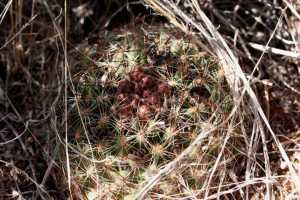
|
I knelt down resting on my
elbows and took a couple of photos. I felt a sense of relief and of
euphoria having found this species for the first time. Just as I was
taking the photos I noticed another plant this time bigger at 3” growing
underneath a small shrub just a few feet in front of me: on closer
inspection it was in full bud and looked only maybe a week or two away
from flowering. Likewise I took some photos which were hindered by the
branches of the shrub which I gently pushed out of the way not wanting to
do any harm, I also took a general photo of the habitat showing the grassy
area dotted by small shrubs and there on the horizon the spectacular view
of the snow capped Abajo Mountains. |
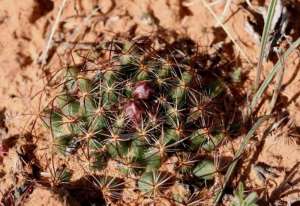
|
Nearby I found an old rusty
beer can so I marked the spot and took a diagonal route past an old grey gnarled
tree back to the car as I wanted to fetch my macro lens and get a couple of
better photos. Returning I soon found the spot again and took some more photos.
I said my farewells; yes I sometimes talk to the plants and took a different
route back to the car checking the ground as I went. A short distance away I
found a couple more Pediocactus simpsonii, small plants around 2”
across with nice dark spines and partly submerged in the soft sandy soil. More
photos and then elated I walked back to the car and drove back down to the main
road. I wanted to visit the Canyonlands NP but didn’t think I’d make it on
what fuel I had left so decided to drive back to Monticello and refuel. With a
full tank and refreshed by a coffee I drove back and into the Canyonlands NP
where I saw Sclerocactus parviflorus again with particularly long central
spines and an Echinocereus species. I then watched the sunset over the amazing
scenery, a beautiful end to a great day!
Vic
|
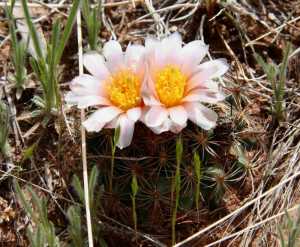
Above: I
asked my friend Richard Booth to look out for this simpsonii and this is
one of Richard’s pictures of Pediocactus simpsonii in flower at
the same site a month after Vic's visit. I have chosen a small plant like
those I saw on my first visit but many plants pictured by Richard were ‘normal’
size. Pity... I thought, maybe, it was something 'new'. Maybe next
time...? |
Thanks Vic,
that bought back some fond memories I have for this part of the world. Vic was
able to find Pediocactus simpsonii for the first time and this is a
fairly small growing form - very small when I found these plants in 2001. In
many places it is a very common cactus but it is interesting that the Sclerocactus
parviflorus Vic found was close to the altitude record for the species. The
‘inermis’ form of Echinocereus triglochidiatus is of course a
desirable plant to cultivate and interesting to see, and I must return to this
site in the future.
Vic mentioned
that he was low on fuel. So was I when I visited this area for the second time
in 2002. We had stopped at the fascinating nearby petroglyphs at ‘Newspaper
Rock’ in Canyonlands. The Pediocactus site was on the way to Monticello over a
dirt road. Shortly the car began to ‘boing’ and the message ‘low on gas’
was displayed. Then, as I approached the Pediocactus site, it went ‘boing,
boing, get some gas NOW, dumbo!’ I tried to reassure the FL that it was a busy
route and we would get a lift, she was not reassured. You just know that
stopping the car to look at some interesting cactus makes it run out of petrol
quicker. Bearing in mind I might have to live with the FL for the rest of my
life, I drove by. It hurt. As we raised the crest I said we could just coast
down the pass to town, but I heaved a sigh of relief, only eight miles to go.
When we came to the main road with its gas station I took a look at the price
and muttered, ‘I’m not buying petrol at that price!. A handbag bounced off
my right ear and I changed my mind. Cactus hunting can be a dangerous pastime!
Trev
|







